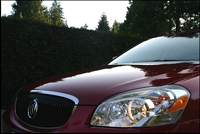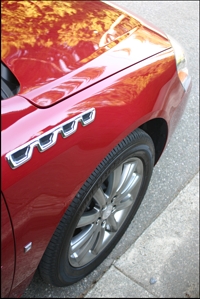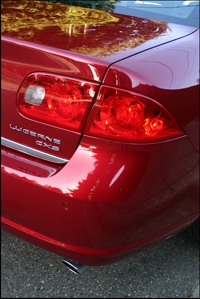Where it suffers most, however, is in fuel consumption. That rumbling exhaust note I like so much is an auditory reminder of the old
 |
| Fuel consumption, well, literally sucks at an average of 16.6 L/100 km. (Photo: Trevor Hofmann, Canadian Auto Press) |
Northstar's single weakness, a penchant for gasoline - fortunately it doesn't call for premium. During my test I averaged about 16.6 L/100 km, a great deal thirstier than the 12.9 L/100 km average in the Azera and even better 11.6 L/100 km average with the Avalon. I don't know about you, but the cost of fuel is changing my driving habits. The additional stops to refuel also diminish the V8-powered Lucerne's convenience quotient too.
It's possible that ride and handling will matter more to some Lucerne buyers, and to this end I have mixed feelings. Firstly, its ride is fabulous; compliant
 |
| Love those portholes (four showing V8 status or three for V6, just like the old days) and 18-inch rims, though. (Photo: Trevor Hofmann, Canadian Auto Press) |
and comfortable, it takes care of badly cared for inner city streets without raising a fuss and tracks extremely well on the open highway, although gets a bit floaty at speeds I'd rather not mention. I think I surprised an Audi A4 driver who attempted to accelerate away from me on the highway merge, though. I had no problems keeping up, and when we hit the highway even less of a challenge leaving him behind. In tight corners the Lucerne CXS, equipped with standard 18-inch alloy wheels and Bridgestone tires, incidentally, tends to understeer, but unless pushed extremely hard, it remains composed and relatively horizontal to the road surface. Just the same, a sport sedan it's not. It is well-mannered, however, and deserves credit for at the very least breaking front-wheel traction in a predictable, progressive fashion.
It should be mentioned that the Lucerne doesn't achieve its good manners by accident, but rather its chassis architecture has been pulled from the very place Buick nabbed its top-line engine, Cadillac. This is the old DeVille chassis, now stretched and widened for the new DTS. Again, such
 |
| Taillights are my favourite design detail... really nicely executed. (Photo: Trevor Hofmann, Canadian Auto Press) |
is the reason Buick was able to fit in Magnetic Ride Control - the first time the technology, pioneered in Chevy's Corvette and a variety of Cadillac models, has been made available in the Buick lineup. Also part of the package is StabiliTrak electronic stability control, improving the car's overall ability to remain within its lane when dealing with slippery roads and potentially avoid an accident. Traction control is also part of the standard package, whether equipped with a V6 or V8. So while the Lucerne might not be able to carve up the corners like a VW Passat or even the new Camry, quite agile by the way, it offers a wonderful ride and handling balance that should surely please Buick buyers, or most others looking to buy into the entry-level luxury segment.
Its lightweight steering should also be popular to those who normally buck up for a Buick, making in-town parallel parking easy and negotiating dense traffic effortless, although managing tight parking lots or making U-turns can be hampered due to the car's gargantuan 13.4 metre (44-foot) turning circle. The steering tightens up on the highway, which is good, but, like the chassis, probably not enough to appease sport-oriented drivers. It's a bit dead at centre too, unfortunately expected from this brand, although its off-centre response is rather abrupt due to more power assistance than I like.

